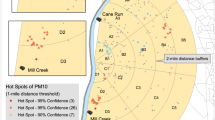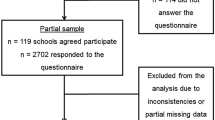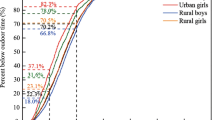Abstract
Background
A child’s ability to succeed in social interactions and in a school setting are important for their development and growth. Exposure to environmental pollutants has been associated with poorer school performance and fewer social interaction in children. Fly ash, a waste product generated when burning coal for energy, is comprised of small glass spheres with neurotoxic heavy metal(loid)s found to be risk factors for learning and social problems in school.
Objective
The purpose of this novel study was to assess the association of fly ash in children’s homes with school and social competency.
Methods
We recruited children aged 6–14 years old from communities located within 10 miles of two coal-burning power plants. In homes of the participants, fly ash was collected on polycarbonate filters using personal modular impactors. We measured school competency and social competency using the validated Child Behavioral Checklist. Using Tobit and linear regression we investigated the relationship of indoor fly ash with school and social competency.
Results
Forty-three percent of children in the study had fly ash in their homes. In covariate-adjusted Tobit models, children with fly ash in their homes scored on average 2.63 (95% CI: −4.98, −0.28) points lower on the school competency scale than peers without ash in their homes. We did not observe that fly ash in homes was related with lower social competency.
Significance
Results from this study suggest that children with fly ash in their homes had poorer performance in the school setting, compared to peers without fly ash in their homes. In the US, coal-fired power plants are being closed, however health concerns about pollution from coal ash storage facilities remains. Findings from this study can provide impetus for creating of public health policy and to highlight the need future research on children’s exposure to fly ash.
Impact
Children’s growth and development are impacted by their social interactions and ability to perform in school settings. Environmental pollutants may impact these essential elements of development. Millions of children are exposed to fly ash which is a waste product generated from burning coal. Fly ash, an environmental health threat throughout the world, is comprised of small glass spheres with trace concentrations of neurotoxic metal(loid)s. Findings from this research show that children with fly ash in their homes are significantly more likely to have poorer school performance than children without fly ash in their homes.
This is a preview of subscription content, access via your institution
Access options
Subscribe to this journal
Receive 6 print issues and online access
$259.00 per year
only $43.17 per issue
Buy this article
- Purchase on Springer Link
- Instant access to full article PDF
Prices may be subject to local taxes which are calculated during checkout
Similar content being viewed by others
Data availability
The datasets generated and analyzed during the current study are not available for other researchers or the public. Upon completion of the study, our research team agreed with all the study participants to delete all data related to this study. The statement was included in the written consent form.
References
Clark-Reyna SE, Grineski SE, Collins TW. Residential exposure to air toxics is linked to lower grade point averages among school children in El Paso, Texas, USA. Popul Environ. 2016;37:319–40. https://doi.org/10.1007/s11111-015-0241-8
Grineski SE, Collins TW, Adkins DE. Hazardous air pollutants are associated with worse performance in reading, math, and science among US primary schoolchildren. Environ Res. 2020;181:108925. https://doi.org/10.1016/j.envres.2019.108925
Lu W, Hackman DA, Schwartz J. Ambient air pollution associated with lower academic achievement among US children: a nationwide panel study of school districts. Environ Epidemiol. 2021;5:e174. https://doi.org/10.1097/EE9.0000000000000174
Pastor M, Morello-Frosch R, Sadd JL. Breathless: schools, air toxics, and environmental justice in California. Policy Stud J. 2006;34:337–62. https://doi.org/10.1111/j.1541-0072.2006.00176.x
Byoung-Suk K, Mohai P, Lee S, Sametshaw AM. Proximity of public schools to major highways and industrial facilities, and students’ school performance and health hazards. Environ Plan B Urban Anal City Sci. 2018;45:312–29. https://doi.org/10.1177/0265813516673060
Mohai P, Byoung-Suk K, Lee S, Ard K. Air pollution around schools is linked to poorer student health and academic performance. Health Aff. 2011;30:852–62. https://doi.org/10.1377/hlthaff.2011.0077
Ritz B, Liew Z, Yan Q, Cui X, Virk J, Ketzel M, et al. Air pollution and autism in Denmark. Environ Epidemiol. 2018;2:e028. https://doi.org/10.1097/EE9.0000000000000028
McGuinn LA, Windham GC, Kalkbrenner AE, Bradley C, Di Q, Croen LA, et al. Early life exposure to air pollution and autism spectrum disorder: findings from a multisite case-control study. Epidemiology. 2020;31:103–14. https://doi.org/10.1097/EDE.0000000000001109
Jung CR, Lin YT, Hwang BF. Air pollution and newly diagnostic autism spectrum disorders: a population-based cohort study in Taiwan. PLoS One. 2013;8:e75510 https://doi.org/10.1371/journal.pone.0075510
Chen G, Jin Z, Li S, Jin X, Tong S, Liu S, et al. Early life exposure to particulate matter air pollution (PM1, PM2.5 and PM10) and autism in Shanghai, China: a case-control study. Environ Int. 2018;121(Pt 2):1121–7. https://doi.org/10.1016/j.envint.2018.10.026
Thygesen M, Holst GJ, Hansen B, Geels C, Kalkbrenner A, Schendel D, et al. Exposure to air pollution in early childhood and the association with Attention-Deficit Hyperactivity Disorder. Environ Res. 2020;183:108930. https://doi.org/10.1016/j.envres.2019.108930
Min JY, Min KB. Exposure to ambient PM10 and NO2 and the incidence of attention-deficit hyperactivity disorder in childhood. Environ Int. 2017:221–227. https://doi.org/10.1016/j.envint.2016.11.022
American Coal Ash Association. Coal combustion products production & use reports. AACA CCP Survey Results and Production & Use Charts. https://acaa-usa.org/publications/production-use-reports/ Accessed January 2022.
Black Leadership Foundation, Clean the Air, Georgia Coalition for the People’s Agenda, The Southern Organizing Committee for Economic and Social Justice. African Americans & power plant pollution. https://www.catf.us/resource/air-of-injustice-african-americans-and-power-plant-pollution/. Accessed December 2021.
United States Commission on Civil Rights. Environmental justice: Examining the Environmental Protection Agency’s compliance and enforcement of Title VI and Executive Order 12898. https://www.usccr.gov/files/pubs/2016/Statutory_Enforcement_Report2016.pdf. Accessed December 2021.
EarthJustice. Communities of color, poverty bear burden of air pollution. https://earthjustice.org/news/press/2011/communities-of-color-poverty-bear-burden-of-air-pollution. Accessed December 2021.
United States Environmental Protection Agency (EPA) proposed rule: hazardous and solid waste management system; identification and listing of special wastes; disposal of coal combustion residuals from electric utilities. Federal Register 2010; 75:35128-35264.
Mueller SF, Mallard JW, Mao Q, Shaw SL. Fugitive particle emission factors for dry fly ash disposal. J Air Waste Man Assoc. 2013;63:806–818.
Kravchenko J, Lyerly HK. The impact of coal-powered electrical plants and coal ash impoundments on the health of residential communities. NC Med. 2018;79:289–300.
Hahad O, Lelieveld J, Birklein F, Lieb K, Daiber A, Munzel T. Ambient air pollution increases the risk of cerebrovascular and neuropsychiatric disorders through induction of inflammation and oxidative stress. J Mol Sci. 2020;21:4306. https://doi.org/10.3390/ijms21124306
Johnson SB, Blum RW, Giedd JN. Adolescent maturity and the brain: the promise and pitfalls of neuroscience research in adolescent health policy. J Adolesc Health. 2009;45:216–221. https://doi.org/10.1016/j.jadohealth.2009.05.016
Zierold KM, Sears CG, Myers JV, Brock GN, Zhang CH, Sears L. Exposure to coal ash and depression in children aged 6-14 years old. Environ Res. 2022;214(Pt 3):114005. https://doi.org/10.1016/j.envres.2022.114005
Zierold KM, Sears CG, Hagemeyer, Brock GN, Polivka BJ, Zhang CH, et al. Protocol for measuring indoor exposure to coal fly ash and heavy metals, and neurobehavioural symptoms in children aged 6 to 14 years old. BMJ Open. 2020;10:e038960 https://doi.org/10.1136/bmjopen-2020-038960
Achenbach TM, Rescorla, LA, Manual for the ASEBA school-age forms & profiles. Burlington, VT: University of Vermont, Research Center for Children, Youth and Families; 2001.
Costa LG, Cole TB, Dao K, Chang YC, Garrick JM. Development impact of air pollution on brain function. Neurochem. 2019;131:104580. https://doi.org/10.1016/j.neuint.2019.104580
Chen Z, Salam MT, Eckel SP, Breton CV, Gilliland FD. Chronic effects of air pollution on respiratory health in Southern California children: findings from the Southern California Children’s Health Study. J Thorac Dis. 2015;7:46–58. https://doi.org/10.3978/j.issn.2072-1439.2014.12.20
Nhung NTT, Amini H, Schindler C, Joss MK, Dien TM, Probst-Hensch N, et al. Short-term association between ambient air pollution and pneumonia in children: A systematic review and meta-analysis of time-series and case-crossover studies. Environ Pollut. 230:1000–8. https://doi.org/10.1016/j.envpol.2017.07.063
Baek J, Kash BA, Xu X, Benden M, Roberts J, Carrillo G. Association between ambient air pollution and hospital length of stay among children with asthma in South Texas. Int J Environ Res Public Health. 2020;3812. https://doi.org/10.3390/ijerph17113812
Cao B, Chen Y, McIntyre RS. Comprehensive review of the current literature on impact of ambient air pollution and sleep quality. Sleep Med. 2021;79:211–9. https://doi.org/10.1016/j.sleep.2020.04.009
Moonie SA, Sterling DA, Figgs L, Castro M. Asthma status and severity affects missed school days. J Sch Health. 2006;76:18–24. https://doi.org/10.1111/j.1746-1561.2006.00062.x
Moonie S, Sterling DA, Figgs LW, Castro M. The relationship between school absence, academic performance, and asthma status. J Sch Health. 2008;78:140–8. https://doi.org/10.1111/j.1746-1561.2007.00276.x
Evans A, Farewell D, Demmler J, Bandyopadhyay A, Powell CVE, Paranjothy S. Association of asthma severity and educational attainment at age 6-7 years in a birth cohort: population-based record-linkage study. Thorax. 2021;76:116–25. https://doi.org/10.1136/thoraxjnl-2020-215422
Zhang CH, Sears L, Myers JV, Brock GN, Sears CG, Zierold KM. Proximity to coal-fired power plants and neurobehavioral symptoms in children. J Expo Sci Environ Epidemiol. 2022;32:124–34. https://doi.org/10.1038/s41370-021-00369-7
Zierold KM, Odoh C. A review on fly ash from coal-fired power plants: chemical composition, regulations, and health evidence. Rev Environ Health. 2020;35:401–18. https://doi.org/10.1515/reveh-2019-0039
Perera F, Li TY, Zhou ZJ, Yuan T, Chen YH, Qu L, et al. Benefits of reducing prenatal exposure to coal-burning pollutants to children’s neurodevelopment in China. Environ Health Perspect. 2008;116:1396–400. https://doi.org/10.1289/ehp.11480
Tang D, Lee J, Muirhead L, Li TY, Qu L, Yu J, et al. Molecular and neurodevelopmental benefits to children of closure of a coal burning power plant in China. PLoS ONE. 2014;9:e91966. https://doi.org/10.1371/journal.pone.0091966
Tang D, Li TY, Liu JJ, Chen YH, Qu L, Perera F. PAH-DNA adducts in cord blood and fetal and child development in a Chinese cohort. Environ Health Perspect. 2006; 114: 1297–300. https://doi.org/10.1289/ehp.8939
Magnuson K. Maternal education and children’s academic achievement during middle childhood. Dev Psychol. 2007;43:1497–512. https://doi.org/10.1037/0012-1649.43.6.1497
Alcaraz M. Beyond financial resources: the role of parents’ education in predicting children’s educational persistence in Mexico. Int J Educ Dev. 2020;75:102188. https://doi.org/10.1016/j.ijedudev.2020.102188
Acknowledgements
The authors would like to acknowledge and thank Lindsay Tompkins, Chisom Odoh, Jack Pfeiffer, Carol Norton, Jillian Winn, and Paula Kingsolver for their assistance with the overall study. We would like to thank the community and community leaders for their participation in this study. In addition, the authors would like to acknowledge C Hanchette (deceased, October 2017) for her contributions to the overall study. This work was supported by the National Institutes of Health, National Institute of Environmental Health Sciences [R01ES024757, PI Zierold]. This manuscript represents the author’s research, ideas, and opinions. The funding agency had no role in the development of the manuscript, analysis of the data, or submission of the work. This manuscript does not reflect the views or opinions of the agency.
Author information
Authors and Affiliations
Contributions
KMZ: Conceptualization, Methodology, Investigation, Data Curation, Writing Original Draft, Supervision, Project Administration, Funding Acquisition. JVM: Methodology, Formal Analysis, Writing-Original Draft, Visualization. GNB: Methodology, Writing-Review & Editing, Supervision. CGS: Methodology, Investigation, Data Curation, Writing—Review & Editing. CHZ: Data Curation, Investigation, Writing—Review & Editing. LS: Investigation, Data Curation, Writing—Review & Editing, Supervision, Project Administration.
Corresponding author
Ethics declarations
Competing interests
The authors declare no competing interests.
Ethics approval
This study was approved by the University of Louisville Institutional Review Board (IRB #14.1069).
Additional information
Publisher’s note Springer Nature remains neutral with regard to jurisdictional claims in published maps and institutional affiliations.
Rights and permissions
Springer Nature or its licensor (e.g. a society or other partner) holds exclusive rights to this article under a publishing agreement with the author(s) or other rightsholder(s); author self-archiving of the accepted manuscript version of this article is solely governed by the terms of such publishing agreement and applicable law.
About this article
Cite this article
Zierold, K.M., Myers, J.V., Brock, G.N. et al. Indoor coal ash and school and social competency among children aged 6–14 years. J Expo Sci Environ Epidemiol 33, 434–438 (2023). https://doi.org/10.1038/s41370-022-00500-2
Received:
Revised:
Accepted:
Published:
Issue Date:
DOI: https://doi.org/10.1038/s41370-022-00500-2



